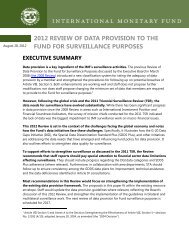ECB Annual Report on supervisory activities
ssmar2016.en.pdf?utm_source=POLITICO.EU&utm_campaign=b1bb431652-EMAIL_CAMPAIGN_2017_03_23&utm_medium=email&utm_term=0_10959edeb5-b1bb431652-189797857&utm_source=POLITICO
ssmar2016.en.pdf?utm_source=POLITICO.EU&utm_campaign=b1bb431652-EMAIL_CAMPAIGN_2017_03_23&utm_medium=email&utm_term=0_10959edeb5-b1bb431652-189797857&utm_source=POLITICO
You also want an ePaper? Increase the reach of your titles
YUMPU automatically turns print PDFs into web optimized ePapers that Google loves.
Based <strong>on</strong> the assessment methodology, the thematic review was launched in<br />
coordinati<strong>on</strong> with an EBA survey 14 for more than 100 significant instituti<strong>on</strong>s in<br />
December 2016, with the JSTs evaluating the level of preparedness of banks and<br />
their implementati<strong>on</strong> practices. This evaluati<strong>on</strong> is to be followed by a horiz<strong>on</strong>tal<br />
analysis which, taking into account the results of the above-menti<strong>on</strong>ed EBA survey,<br />
will benchmark banks against their peers. The results of the thematic review are<br />
expected to c<strong>on</strong>tribute to a proper and c<strong>on</strong>sistent implementati<strong>on</strong> of IFRS 9 and its<br />
provisi<strong>on</strong>ing policies by 1 January 2018, the effective date of IFRS 9.<br />
Risk data aggregati<strong>on</strong> and risk reporting<br />
Sound risk management rests <strong>on</strong> firm-wide data quality, effective risk data<br />
aggregati<strong>on</strong> and internal reporting practices. However, a key less<strong>on</strong> from the<br />
financial crisis was that certain banks were unable to fully identify risk exposures.<br />
The reas<strong>on</strong>s were a lack of adequate risk informati<strong>on</strong> together with weak risk data<br />
aggregati<strong>on</strong> practices. The affected banks’ ability to take timely decisi<strong>on</strong>s was<br />
seriously damaged, with wide-ranging c<strong>on</strong>sequences for the banks themselves and<br />
the financial sector as a whole.<br />
Against this backdrop, the thematic review <strong>on</strong> risk data aggregati<strong>on</strong> and risk<br />
reporting was am<strong>on</strong>g the 2016 <strong>supervisory</strong> priorities. Its objective was to assess the<br />
effectiveness of risk data aggregati<strong>on</strong> and risk reporting practices as well as related<br />
IT infrastructure. This assessment is mainly guided by the BCBS 239 Principles for<br />
effective risk data aggregati<strong>on</strong> and risk reporting.<br />
In early 2016 <str<strong>on</strong>g>ECB</str<strong>on</strong>g> Banking Supervisi<strong>on</strong> launched the thematic review <strong>on</strong> effective<br />
risk data aggregati<strong>on</strong> and risk reporting for a subset of banks under its direct<br />
supervisi<strong>on</strong>. The sample included two groups of banks. First, those banks which<br />
were involved in the BCBS 239 self-assessment performed by the Basel Committee<br />
in 2013 and 2014 – this group was largely identical with the group of banks classified<br />
as global systemically important banks at the time. Sec<strong>on</strong>d, a further set of banks<br />
was included in the sample in order to broaden it.<br />
The thematic review is being performed by JSTs with the support of a centralised<br />
working group, comprising members of the <str<strong>on</strong>g>ECB</str<strong>on</strong>g> and NCAs. The latter provide<br />
operati<strong>on</strong>al guidance and ensure c<strong>on</strong>sistent applicati<strong>on</strong>. The work is carried out in<br />
line with the principle of proporti<strong>on</strong>ality and was divided into two main phases in<br />
2016. During Phase 1 appropriate operati<strong>on</strong>al guidelines for analysing and<br />
assessing the compliance status were developed, with a focus <strong>on</strong> risk type (credit<br />
risk, liquidity risk, counterparty credit risk, operati<strong>on</strong>al risk, interest rate risk in the<br />
banking book – IRRBB – and market risk). Phase 2 comprised a deep-dive analysis<br />
of the liquidity risk and credit risk dimensi<strong>on</strong>s. First, banks in scope were asked to<br />
provide a specific set of liquidity and credit risk data in a compressed period of time<br />
(fire drill exercise). Sec<strong>on</strong>d, the same banks were requested to show their data<br />
14<br />
Sec<strong>on</strong>d impact assessment of IFRS 9 <strong>on</strong> EU banks.<br />
<str<strong>on</strong>g>ECB</str<strong>on</strong>g> <str<strong>on</strong>g>Annual</str<strong>on</strong>g> <str<strong>on</strong>g>Report</str<strong>on</strong>g> <strong>on</strong> <strong>supervisory</strong> <strong>activities</strong> 2016 − Supervisory c<strong>on</strong>tributi<strong>on</strong> to financial<br />
stability 24



